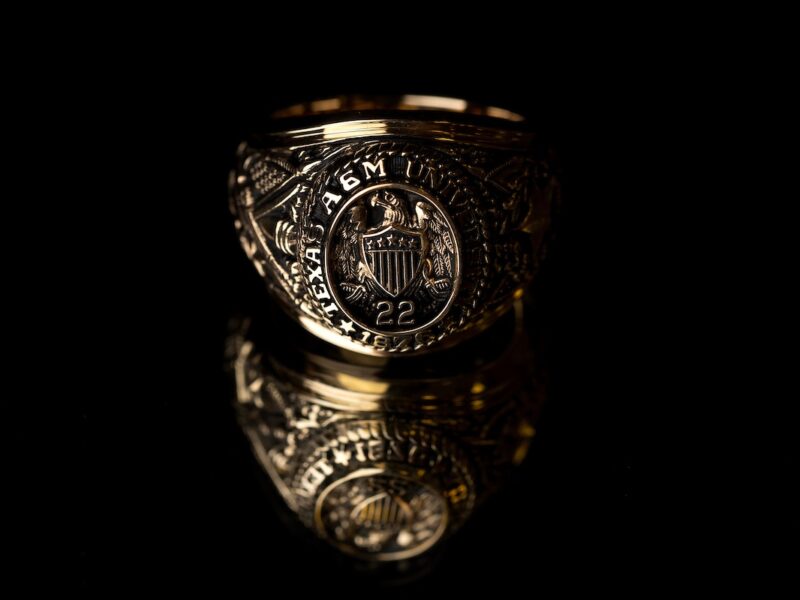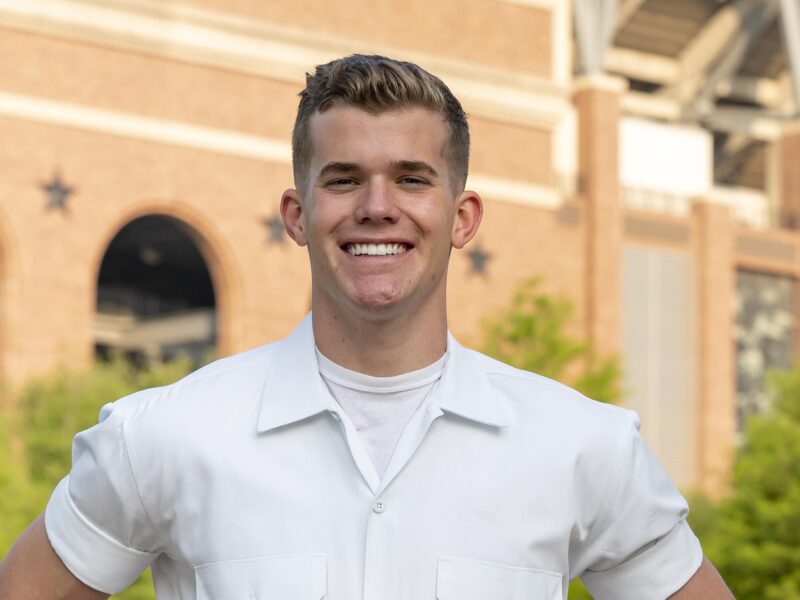“Aggie War Hymn” Writer Pinky Wilson Honored
Taking advantage of a World War I lull, James Vernon “Pinky” Wilson scribbled the words on the back of an envelope for a song that has become dear to hundreds of thousands of Aggies and familiar to millions of others throughout the nation — the “Aggie War Hymn.” Nearly a century after Wilson penned his rousing “fight song” lyrics, a statue was placed on the Texas A&M University campus as a lasting tribute to him.
The life-size bronze statue depicting the Class of ’20 Aggie in his battlefield uniform is a gift from Jeff and Ray Harper of San Angelo and their Aggie children, Will, J.D. and Christin, friends of the Wilson family and Texas A&M supporters.

The statue is located on the west side of the Sanders Corps of Cadets Center near the heart of the Texas A&M campus, and was formally unveiled Saturday (Oct. 11).
Texas A&M Associate Executive Vice President for Operations Larry Boleman was instrumental in arranging for the statue to be displayed on campus. (Proudly posing beside the statue of J. V. “Pinky” Wilson are from left, Bill Wilcox, who facilitated the project to create the statue; Texas A&M President Elsa Murano; Joe Wilson, son the late Mr. Wilson; Gene Taylor, a family friend, and two members of the Aggie Band, Pedro Vega and Ben Torres.)
Artisans at A.C. Memorials used a photograph that is on display at two locations on campus — the Adams Band Hall, headquarters for the Aggie Band, and the Sanders Corps of Cadets Center — to design the statue.
Wilson joins a select few Texans honored with statues on the campus of the state’s first institution of higher learning — and will only be the fourth former student to be so enshrined.
The first Aggie enshrined in bronze was the late E. King Gill, the original 12th Man who came out of the Cotton Bowl stands in 1922, put on the uniform of an injured player and was ready to enter the game and help the team. That inspired Aggies ever since to stand throughout football games to show their support for the team and be willing to enter the fray if needed—and is symbolic of their support for one another and for their school. Gill, whose statue is an attraction at the north end of Kyle Field, the university’s 82,000-seat football stadium, graduated in 1924.
More recently, a statue was erected to honor the memory of the late Gen. Earl Rudder, the World War II army hero who later served as president of Texas A&M. The 1932 Texas A&M graduate is generally credited with laying the foundation for the university’s transformation from an all-male predominately military school into the 48,000-student comprehensive co-educational institution that it is today. The Rudder statue is placed near the 11-story building and auditorium complex that bears his name.
Also, a statue honoring Gen. James F. Hollingsworth, a 1940 Texas A&M graduate whose illustrious army career spanned an era from World War II to Viet Nam, is prominently placed in the Corps of Cadets area. He resides in San Antonio.
Wilson, who was born in Williamson County near Georgetown and grew up in Florence, volunteered for the Marine Corps in 1917 during his junior year at Texas A&M and soon shipped out for France.
It was while there that he reportedly used the back of an envelope containing a letter from his parents to write the words to the song that is played by the Aggie Band several times during football games, as well during a host of other sports events and university activities.
Wilson’s originally penned “Aggie War Hymn” lyrics included a verse that made reference to only one other school — the passage about “so long to the orange and the white.” Wilson tried in 1938 to expand on that version with some substitute wording that he considered more appropriate because it could apply equally to all athletic opponents. Aggies never bought into that idea, so the original version is still sung with gusto, the opponent notwithstanding.
One of the hymn’s most unusual aspects is its opening line, “Hullabaloo, Caneck Caneck,” which has prompted interpretation consternation over the years and reportedly dates back to a phrase from a 1907 Aggie yell (Aggies “yell” at games, they don’t “cheer”). Questions about the passage’s meaning have been posed over the intervening years, prompting the late Jack K. Williams, another prominent Texas A&M president, to tell an inquirer that “It is Chickasaw Indian for ‘Beat the Hell out of the University of Texas’.”





